#Gwenfrewy
Text
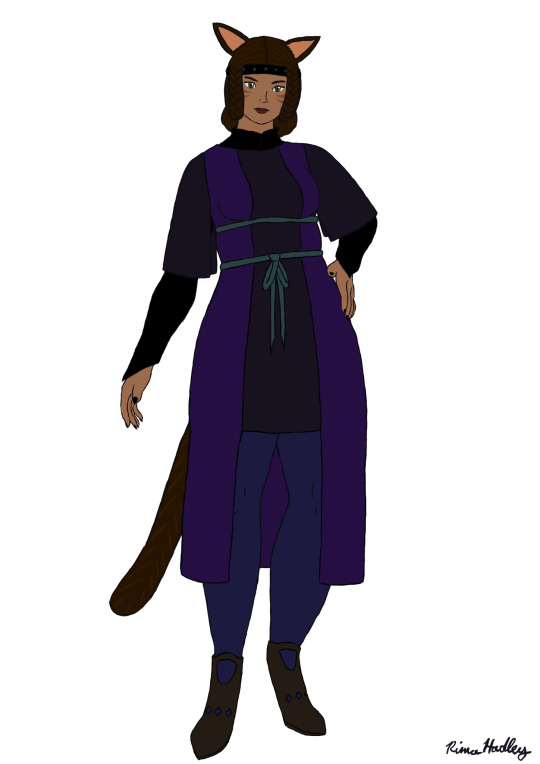
I designed Orphne Amraut, a witch and graduate of Gwenfrewi College at Aberddraig University (Fantasy Oxford). When her best friend Elaine uncovers evidence of an imminent invasion from the Otherworld, Orphne abandons her plans to stick around at Gwenfrewi studying whatever catches her fancy, following Elaine on her quest to save the land. The two soon team up with Mihri Ninaka, a traveling adventurer and expert in ancient legends and songs.
Orphne's outfit is loosely inspired by Oxford academic gowns, but the blue stockings are a reference to the Blue Stocking Society.
#my art#my ocs#oc: orphne amraut#mihriverse#i need to. actually name this setting#gwen's log#twilight gest#(very early tg development)
7 notes
·
View notes
Note
!! :)
Alrighty! Meet Greenie, full name Gwenfrewi Godschild.
Species: Verdan Goblin. Also variable. Her life is complicated right now.
Occupation: Cleric (trickery and chaos), healer, and fortune teller. Also currently ceiling painter, spy, and professional voice in head.
A person named Godschild would normally bring to mind luck, prosperity, importance, reverence. For the Verdan it labels those children who have too strong a connection to That Which Endures. Greenie lost her clan and her name for the chaos that followed in her wake as a child. Sent into the wilds of the Underdark once she came of age, she found her way to the surface. She fostered her craft, able to somewhat warp the weft of fate, and she found a teacher in a certain older, no less bratty, horrible little blond aasimar. The threads of fate are complicated.
She flitted from place to place, never welcome for too long- folks are suspicious of goblins and more so of goblins who can't keep the same face from day to day. On the road, she found her first companions- Selbi, River, Irax, and Pyr. Unfortunately, the party was brought to an abrupt end on one ill-fated excursion in a lich's old lab. Greenie was killed by a room with teeth. She still doesn't fully trust sparse furnishings. Even more unfortunately, the lich took an interest in her corpse in particular, seeing it as an academic curiosity in the study of chaos. He decoupled the shape of her soul even further, stoking the chaos within her until she could not maintain even the same species from day to day. When he grew bored, he disposed of her, returning her in the form of a (surprisingly lethal) potted plant to Selbi.
Misadventure led to misadventure, she struck up a firm... well, it's hard to describe... with a tabaxi man named Dust. And now, after a rather inadvisable bout of goblin curiosity, her body is stuck to his ceiling and her soul lives inside his head. They have a good relationship, she can still do the things she loves, and when he needs privacy she can shunt herself back into her body and paint the ceilings for an hour or so.

#my characters and other animals#meet the characters#dnd 5e#fallcrest#oc: a different kind of simplicity
5 notes
·
View notes
Text

SAINTS NOVEMBER 03
St. Peter Francis Neron, Roman Catholic Priest and Vietnamese Martyr. He served as the director of the main seminary until he was arrested and beheaded by authorities.
St. Winifred. According to legend, she was the daughter of a wealthy resident of Tegeingl, Flintshire, Wales, and the sister of St. Beuno. She was most impressed by Beuno, was supposedly beheaded on June 22 by one Caradog when she refused to submit to him, had her head restored by Beuno, and sometime later, became a nun of the convent of a double monastery at Gwytherin in Denbigshire. She succeeded an Abbess Tenoy, as Abbess and died there fifteen years after her miraculous restoration to life. A spring supposedly springing up where Winifred's head fell is called Holy Well or St. Winifred's Well and became a great pilgrimage center where many cures have been reported over the centuries. She is also known as Gwenfrewi.
St. Vulganius, 704 A.D. Irish or Welsh missionary and hermit. After working to evangelize the tribes of the Atrebati in France, he became a hermit at Arras.
St. Cristiolus, 7th century. Welsh confessor, the brother of St. Sulian. Cristiolus founded Christian churches, including the parish in Anglesey.
St. Elerius, 6th century. Welsh saint who was a companion of St. Winefred. He was an abbot in a monastery in the north of Wales.
St. Englatius, 966 A.D. A Scottish bishop also called Englat and Tanglen. He lived at Tarves, in Aberdeenshire, Scotland.
St. Malachy O' More, Bishop famous for writing prophecies of the popes. Also listed as Mael Maedoc ua Morgair or Maolrnhaodhog ua Morgair, Malachy was born in Armagh, Ireland, in 1095. He was ordained by St. Cellach or Celsus of Armagh in 1132 and studied under Bishop St. Maichius of Lismore. Malachy reformed ecclesiastical discipline and replaced the Celtic liturgy with the Roman when he served as abbot of Bangor. In 1125 he was made bishop of Connor, using Bangor as his seat. He also established a monastery at Iveragh, Kerry. He was named archbishop of Armagh in 1129. In 1138, he resigned and made a pilgrimage to Rome. He visited St. Bernard at Clairvaux, France, wanting to be a monk there, but returned to Ireland to found Mellifont Abbey, also serving as papal legate to Ireland. He returned to Clairvaux and died on November 2 in St. Bernard’s arms. St. Bernard declared him a saint, an action confirmed in 1190 by Pope Clement III. Malachy is known for many miracles, including healing the son of King David I of Scotland. Malachy’s prophecies did not appear until 1597. Tradition states that Malachy wrote them while in Rome and that they were buried in papal archives until 1597, when Dom Arnold de Wyon discovered them. Serious doubts remain as to the true authorship of the prophecies.
ST. SYLVIA, MOTHER OF ST. GREGORY THE GREAT
St. Martin de Porres, Dominican lay brother at the Dominican Friary at Lima and spent his whole life there-as a barber, farm laborer, almoner, and infirmarian among other things. https://www.vaticannews.va/en/saints/11/03/st--martin-de-porres--dominican.html
0 notes
Photo

Simon Evans (ed.), The Welsh Life of St David
As soon as the head of the maiden fell to the ground, a most clear spring burst forth in that very spot and spread itself copiously, offering health to many sick people through the merits of the holy maiden, which even today has not ceased to flow.
Two Medieval Lives of Saint Winefride, translated by R. Pepin and H. Feiss
#The Welsh Life of St David#Two Medieval Lives of Saint Winefride#Gwenfrewy#Dunod#saints and martyrs#miracles
66 notes
·
View notes
Text
Saints&Reading: Tue.,Nov.16, 2021
November 16_November 3
MARTYRS ACEPSIMAS THE BISHOP, JOSEPH THE PRESBYTER, AND AEITHALAS THE DEACON, OF PERSIA (376)

Martyrs Akepsimas the Bishop, Joseph the Presbyter and Aeithalás the Deacon of Persia were leaders of the Christian Church in the Persian city of Naesson. His flock devotedly loved their hierarch for his ascetic life and tireless pastoral work.
The emperor Sapor ordered his men to seek out and kill Christian clergy. Saint Akepsimas also was arrested, even though he was already an eighty-year-old man. They took him to the city of Arbela, where he came before the judge Ardarkh, a pagan priest of the sun god. The holy Elder refused to offer sacrifice to the Persian gods. For this he was fiercely beaten and thrown into prison, where on the following day the seventy-year-old priest Joseph and the deacon Aeithalás were severely beaten and thrown into jail with him. For three years the saints were held in confinement, and suffered from hunger and thirst.
Emperor Sapor came to the temple of the god of fire, located not far from Arbela, and wanted to take a look at the three holy martyrs. Exhausted and covered with festering wounds, the saints were brought before the emperor. When he asked them to worship the pagan gods they firmly refused, confessing their faith in Christ instead.
The holy bishop was beheaded, but the presbyter and deacon were taken into the city to be stoned.
The execution of the presbyter Joseph was prolonged for several hours. A guard was placed near the place of execution, so that Christians would not take the body of the holy martyr. On the fourth night a strong windstorm raged near the city, lightning killed the guard, the wind tossed stones about, and the body of Saint Joseph disappeared.
Deacon Aeithalás was taken to the village of Patrias, where he was stoned. Christians secretly buried his body. A tree grew on the saint’s grave, and its fruit brought healings.
ST. WINIFRED OF TREFFYNON (HOLYWELL), N. WALES, (630)
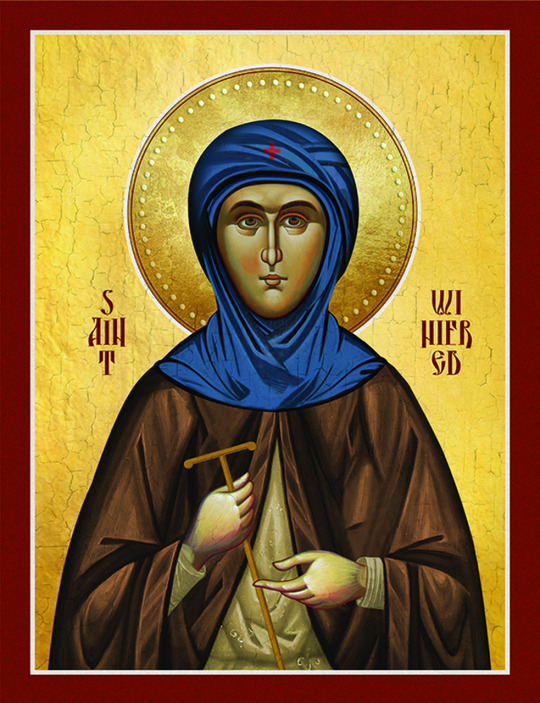
"Saint Winefride (in Welsh, Gwenfrewi) was a maiden of noble birth who lived in North wales in the seventh century. The niece and spiritual daughter of Saint Beuno (21 April), she entered the Monastery of Gwytherin after his death, where she lived under the spiritual direction of Saint Eleril. The son of a neighbouring chieftan, Caradoc by name, seized by an unchaste passion, pursued her and struck off her head with a sword. The spot where her head fell became known as Treffynnon or Holywell, because of the appearing of a healing spring for those who would take its waters with faith. Holywell remains a great place of pilgrimage in Britain to this day." (Synaxarion)

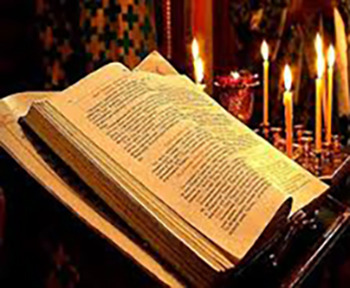
LUKE 11:34-41
34 The lamp of the body is the eye. Therefore, when your eye is good, your whole body also is full of light. But when your eye is bad, your body also is full of darkness. 35 Therefore take heed that the light which is in you is not darkness. 36 If then your whole body is full of light, having no part dark, the whole body will be full of light, as when the bright shining of a lamp gives you light. 37 And as He spoke, a certain Pharisee asked Him to dine with him. So He went in and sat down to eat. 38 When the Pharisee saw it, he marveled that He had not first washed before dinner. 39 Then the Lord said to him, "Now you Pharisees make the outside of the cup and dish clean, but your inward part is full of greed and wickedness. 40 Foolish ones! Did not He who made the outside make the inside also? 41 But rather give alms of such things as you have; then indeed all things are clean to you.
COLOSSIANS 2:20-3:3
20 Therefore, if you died with Christ from the basic principles of the world, why, as though living in the world, do you subject yourselves to regulations- 21 Do not touch, do not taste, do not handle, 22 which all concern things which perish with the using-according to the commandments and doctrines of men? 23 These things indeed have an appearance of wisdom in self-imposed religion, false humility, and neglect of the body, but are of no value against the indulgence of the flesh.
1 If then you were raised with Christ, seek those things which are above, where Christ is, sitting at the right hand of God. 2 Set your mind on things above, not on things on the earth. 3 For you died, and your life is hidden with Christ in God.
3 notes
·
View notes
Text
The Nulama Reapers

Type; Elite Military Forces
Allies;
The Grand Eccumene(Salem)
Imperial Surio
The Sadar Empire
The Kingdom of Mayamar
The Kingdom of Nenlant
The Mixed Union
Enemies;
The United Kingdoms of Rawmaite
Silirin
Ainorilos
Rhodaos
The Kingdom of Galadim
The Kingdom of Eregost
The Republic of Lara
The Republic of the Gwedor
The Curutan Kingdom
Base of Operations;
Nulama(Home base)
The City of Silirin(Captured)
Tamar(Captured)
Anarsta(Allied)
Assaduin(Captured)
Other names;
Grimm lapdogs
Monster collective
Demons
Lesser humans
In-humans
Fallen Souls
Motto; Slaium lat, nar nagaz (Live for you, not others)
Creed;
Everyone’s idea of peace is a Lie
But some measure of it is True
All it takes is the mind to See
Once aware life can be Tamed
However arrogance can lead to Danger
Everyone has a need to Life
But in truth they are lent to it by Death
No matter what happens, what matters is You.


Leaders; Lord Shalom
Baron Ezekiel
Baron Adoniram
Baron Joseph
Baroness Nili
Notable members;
Regent Yasu
Regent Bard
Regent Emen
Regent Absalom
Regent Solomon
Regent Salome
Regent Cynefrid
Regent Siegried
Regent Gwenfrewi
Regent Sakina
Regent Baris
Regent Anwar
Former members;
First Councilor Sulieman
Grand Vizier Shlomo
Grand Admiral Zelimir
Regent Zalman(Unknown)
Regent Sol(Missing)
Baroness Salamatu(Deceased)
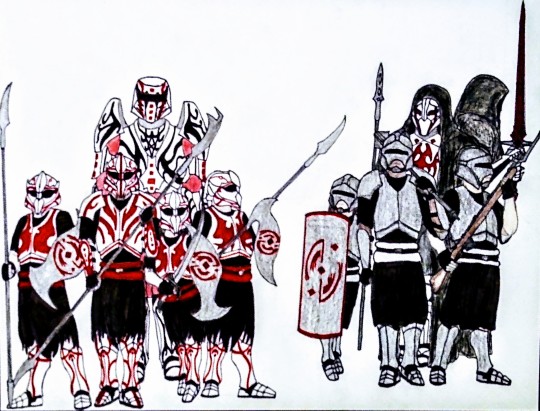
Size; 102,600 personnel
Units;
Assault Reapers
Juggernaut Enforcers
Garrison Infantry
Shadow Rogues
Organization;
The Nulama Reapers; All 4 Branches(102,600)/ Lord Shalom
Branch; 4 Legions:43,200/32,400/16,200/10,800/Baron
Legion; 3 Groups:10,800/8,100/5,400/2,700/Regent
Group; 3 Cohorts:3,600/2,700/1,800/900/ Count
Cohort; 5 Companies:1,200/900/600/300/Harvesters
Company; 5 Sections:240/180/120/60/Binder
Section; 2 patrols:48/36/24/12/Villein
Patrol; 6 cells:24/18/12/6/Sower
Cell; 4 Reapers/3/2/1/Grazer
Ranks;
Lord
Baron/Baroness
Regent
Count/Countess
Harvester
Binder
Villein
Sower
Grazer
Reaper

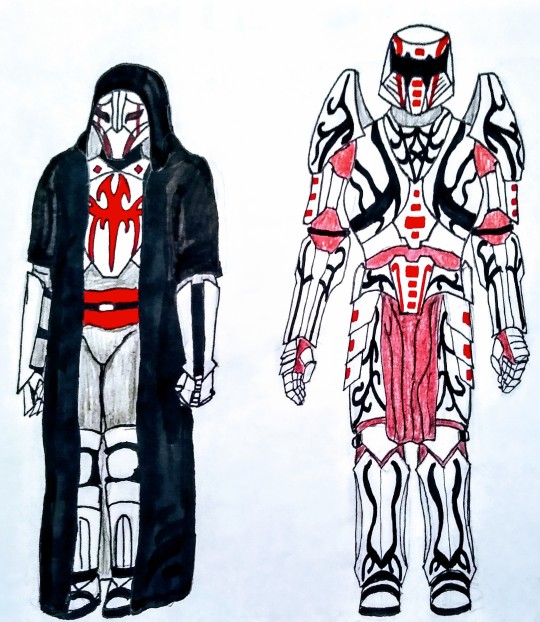
(L-R)
Roles
Assault Reaper; Lead assault and Invasion force
Garrison Infantryman; Territorial occupation, and Front-line defense force
Shadow Rogue; Covert spies and Assassins
Juggernaut Enforcer; Heavy infantry and force multiplier
Assets
Land assets
Creatures of Grimm
Beowolves
Ursai
Nevermores
Geists
Seers
Artillery & Siege engine
Trebuchet
Ballista
Onager
Catapult
Siege tower
Animals
Dogs
Horses
Mules
Oxen
Fortifications
Trenches
Castles
Defensive wall
Hill Forts
Ditches
Naval assets
The Eccumene Fleet of Graying Neutrality
Battleships;3
Warships; 10
Frigates; 15
Brigs; 20
Schooners; 20
Sloops; 26
Brief summary;
The Nulama Reapers were a Independent Army force allied with The Grand Eccumene, and Salem and it was led by Lord Shalom. It was best known for its Grimm aesthetic, high quality soldiers, and supreme strategies. Thus it was feared by those who were aware of them. For others however assumed they were just a rumor,
#rwby#world of remnant#rwby grimm#rwby7#rwby fanfiction#rwby ruby#ruby rose#the silver eyed warriors#rwby salem#rwby maria#rwby summer rose#rwby summer#summer rose#rwby ruby rose
14 notes
·
View notes
Link
https://lornasmithers.wordpress.com/2015/07/05/gwyn-ap-nudd-and-gwallog-ap-lleenog-one-brother-dies-and-the-other-lives-on/ https://www.google.com/amp/s/lornasmithers.wordpress.com/2015/07/05/gwyn-ap-nudd-and-gwallog-ap-lleenog-one-brother-dies-and-the-other-lives-on/amp/ I really like this blog, which appeals to both a cultural/creative interest and a semi-spiritual fascination as well. As I've been attempting to write my 2nd century Artorius, and simultaneously comb through the weeds of the early 20th century 'Lives of the Saints of Britain, Ireland, Wales...yadayadayada...', in my search parsing weird etymologies and philologies, it's become increasingly clear in a very muddled, vaguely understood sense, most of these Saints seem to derive qualities not only from from Arthurian folk history (pre-Continental Romances, other than suspected Breton traditions harkening from Chretian de Troy, and anon's, 'Yder'), but more, the early, preChristain/pagan cults preserved in confused repetitions of saints getting their heads chopped off, sometimes fused back on, wells springing up in place of lost heads; saints adopting qualities of local healing cults; formations of the landscape, losing eyes, saving wild animals, expanding harvests, humbling or elevating kings; granting miracles of blessing and demonstrating marvels of nature, etc. All such characteristics reflecting more ancient, half-forgotten whispers of earlier times and peoples. I'm somewhat obsessed with this little known Yder, who pops up in cameos of Welsh tales and Triads as Edern, the Pedigrees as Aeternus, the Romances as Idernus son of Nudd, the Modena Archivolt rescuing 'Guinloie', in an abduction scene rendered in Stone before Geoffrey of Monmouth detailed the rampant adventurers of Arthur's crew to Anglo-Norman audiences. Yder--who falls in love with a Guenloie (a derivation, one of the many forms of Gwenhwyfar. Take your pick from the Saints: Gwenasedd, Gwenlo, Gwenabwy, Gwenfrewi, Guenoc/Fyndocha/Ninnocha/Gwengustle/Gwehidwy...Gwenfron/Gwen Trierbron--that's 3 White Boobs, btw--amazing woman. Her son is Guenaloe, btw. Go factor that from Gwenlo...). Edern ap Nudd, whose mother was a 'fairy', and relation, sister perhaps, of Eigyr, Arthur's mother. The family lines of pedigrees from Welsh manuscripts are notoriously fraught with mutations, borrowings, corruptions, duplications, and out-and-out invention more than truth. But they're fascinating in light of the mythos of Saints, Legends, Heroes, and forgotten gods. And maybe, a spectre of something that was long ago extant as a human, buried beneath the centuries of forgotten history. If it was history at all. Yder drives from Edern, which seems deduced by Aeternus. There's a whole load of connotation read into that name alone. Eternal. Eder(n), related to a root-word, "eadar/idir", translating as "amongst or between" (in my unschooled approximation of these terms). I don't really think there's a connection, at least not one with any substance more than coincidence, but 'artor' (w/o the Artorius part), translates from the Latin as 'straits/narrow passage/a difficult passage/channel'. Latin synonyms appear as 'angustus', 'arctos positos', 'articular' (joint/joining between 2). And from the early Gaelic, a most intriguing cognate of 'airther', meaning 'East/from the East', as in Sunrise, the Dawn, Rebirth--Eternal. Immortal. Oddly, the root of Ambrosius, derives from ambrose/ambrosia. The sense of which lends itself to the same concepts of eternity and immortality. There are a few heroes who sport this 'name' within the canon of medieval literature, Ambrosius Aurelianus being the most familiar, but also the Irish, 'Expulsion of the Diesi', which describes the settling of the Leinster Irish upon the shores of Wales, and the eventual inseminating of the Diesi into the Welsh nobility of Dyfed/Demetia. Their progenitor, traced back to a warrior named Aedd (sun/fire/) Vroisc. 'Vroisc' being the rendering of 'ambros' into a Goidelic (or maybe Britthonic?) approximate. And amongst the lines of Caledonian chieftains, roughly traced from scattered branches and fragmented lineages to the late 2nd/early 3rd century, a warrior, a king named Art Vroisc, who appears in the ancestery of the Damnonii, who ruled around the territories of DunBarton and the Alclud/Strathclyde, at the western end of the Antonine Wall. In my vision, Artorius might just become Aeternus instead...and his queens, two women, two cousins, divided by that Wall, by custom and upbringing, lands and people. One, to hate Rome, who would give her life to see the Eagles forever sunk into the Great Sea; the other, a princess of Romanized Britain, who would sacrifice herself to see a dream of unity tying both hers and her cousins peoples into a peace that would heal the fractured Isle. They each exist in the tales of Guinevere and Nimue's varied embodiments scattered through Arthurian lore. Vanora, and Nemiane, both names derived from their root characters. Artorius to Art Vroisc to Aeternus to Eder(n) to Yder ap Nudd...the once and future king disguised somewhere in there, perhaps? Rex Quondum et Futurus, is that how it's said??
1 note
·
View note
Text
@serendipityxxi asked Foxglove, Allium, Poinsettia, Hydrangea
foxglove: Name three facts about your family?
Mod: In no particular order or importance, guys.
SR: Ok. Well…um…1) I had an older brother named Matthew and a younger sister named Ella, who both died in infancy; 2) my parents met because a cabinet fell on my dad’s face and my mother was apprenticing under the nurse who stitched him up; and 3) my father’s mother ran away from her Indian boarding school at age 11.
BB: 1) My stepfamily (excepting my dad) were all truly terrible people; 2) my mother’s birth name was Gwenfrewi, and she had three younger sisters: Elen, Luned, and Mabyn; and 3) I have a great-great-niece named Rikki and she drew these two green stick figures on my arm when we met.
PC: 1) My family actually owned land in Virginia before the American Revolution, 2) my brother’s death was misreported and that’s how Sharon exists, and 3) my grandparents met Sarah Forbes Bonetta once, which is quiet nifty.
Allium: What’s the best thing you can cook?
SR: I’m a BEAST at microwaving leftovers.
PC: I’ve been told I’m pretty good with poultry. My brother and I actually used to hunt fowl. I kept the Howlies fed with better stuff than c-rations, when I was in the field with them.
BB: Um…let’s see…my best…?
SR: It’s a false competition. Bucky can cook anything.
PC: I’m convinced Bucky could cook a boot and it would taste good.
Poinsettia: Favorite holiday dish?
PC: TRIFLE.
BB: Tofurkey makes this amazing fake turkey log loaf which is the best turkey I’ve ever had, imitation or not.
SR: My grandmother and I used to handmake cornbread with red beans for Thanksgiving, and I do mean handmake, from drying and grinding the corn ourselves right on up to baking it. I’ve done it every year since we woke up; it’s of course not the same but it’s still my favorite.
Hydrangea: Starbucks order?
PC: We actually try something new every time we’re there! We’re trying to embrace the future, and also avoid getting too comfortable in anything.
2 notes
·
View notes
Text
Sunday Symbolism: meaningful names, part 3: the nuns, part 2
To make sure there’s enough to talk about in this instalment of my Sunday Symbolism, I’ve decided to add both Sister Ursula and Sister Jesu-Emmanuel. Enjoy!
Sister Mary-Cynthia –Cynthia Miller
This one is a bit tricky, because Cynthia was a real person. However, we may see that, even though her parents did not pick her name with CtM in mind, there is some very fitting symbolism going on. Let’s start with the first part of her religious name, ‘Mary’. There are several theories as to the meaning of the name ‘Mary’, which derives from ‘Maria’, which is a derivation of the Hebrew ‘Miryam’. Potential meanings include ‘sea of bitterness’, as well as ‘rebelliousness’. Sister Mary-Cynthia is hardly rebellious, but the ‘sea of bitterness’ may be more fitting. I do not mean to say that Sister Mary-Cynthia is a bitter person, far from it! However, a sea of bitterness does invoke images of sadness, of a world-view that is not always optimistic. Sister Mary-Cynthia suffers from depression. This might make the world appear very sombre to her. Now, my guess is that Cynthia picked it not because of its literal meaning, but because of the Holy Virgin. Who is more fitting than the mother of all mothers when you are a nun and midwife?
On to the next part of her religious name, which is also her Christian name: ‘Cynthia’. This name literally means ‘woman from Kynthos’, which is hardly helpful when we try to decipher its meaning. However, it is also an epithet of the Ancient Greek goddess Artemis, who was famous for remaining a virgin. That seems very fitting for a nun who makes vows of chastity. Artemis was also venerated as the goddess of childbirth, because she assisted her mother during the birth of her twin-brother Apollo. An ancient goddess known for protecting women in childbirth as well as virgins is highly fitting for a nun and midwife.
Now, what is striking about Sister Mary-Cynthia is that the last part of her religious name is also her Christian name. I think this may be foreshadowing for something yet to come. Cynthia was a real person, as I’ve noted. She became a nun for a while, but, in the end, decided that that life was not for her and renounced her vows. Her religious name shows that she still embraces the person she was before, maybe a bit too much.
So, even though Cynthia was a real person, we see that her name is strangely appropriate for her character in CtM.
Sister Winifred – unknown
Unfortunately, we don’t know what Sister Winifred was called before she became a nun (yet. I have hope for series seven, guys). So, we’re just going to analyse her religious name.
‘Winifred’ derives from the name ‘Gwenfrewi’. This name is composed of the Welsh words ‘gwen’, meaning ‘white, fair, blessed’, and ‘frewi’, meaning ‘reconciliation, peace’. Sister Winifred is pale as milk, so I guess that ‘white/fair’ fits her quite well. As a nurse and midwife, she does have to make peace between family members at times, making the second part of her name appropriate.
In all probability Sister Winifred picked her name because of Saint Winifred. Saint Winifred isn’t exactly the most badass of saints; she is mainly known for a spring that spontaneously sprung up on the place where her head fell. This spring or well became a place of pilgrimage. According to legend the water had restorative properties, curing a variety of ailments. What could be more fitting for a nun who spends her days as a midwife and nurse?
Sister Ursula– unknown
Since we don’t know what Sister Ursula’s Christian name is, we’re going to dive straight into her religious name.
‘Ursula’ means ‘little bear’, from the diminutive of the Latin ‘ursa’, which means ‘she-bear’. Also interesting is that in Ancient Greece young girls would sometimes serve a year in temples dedicated to Artemis. They were called arktoi, which means ‘little she-bears’. Artemis, being the goddess of childbirth, therefore not only relates to midwife Cynthia, but also to Sister Ursula, though in a less-direct way. Now, Sister Ursula probably picked this name to honour Saint Ursula. The facts surrounding Saint Ursula are hazy at best; we know that a church in Cologne was built to commemorate a group of martyred virgins. Allegedly, one of those virgins was Ursula, who was sent to marry a pagan prince, but was taken captive by a group of Huns. When she refused to marry their chieftain, she was murdered. There is not much to go on to relate this name to Sister Ursula (then again, she was only in three episodes, so…). I guess we can say that Saint Ursula was pretty headstrong and knew exactly what she wanted, which is something she has in common with Sister Ursula.
Mother Jesu-Emmanuel- unknown
Though we haven’t seen Sister Jesu-Emmanuel in quite some time, I guess I might just as well analyse her, since she is mentioned several times. Like most of the other nuns in this post, we don’t know the non-religious name of Sister Jesu-Emmanuel.
Now, on to her name. ‘Jesu’ basically means ‘Jesus’, which derives from the Hebrew ‘Yehoshu'a’, which means something along the lines of ‘Yahweh is salvation’. Pretty fitting for a Christian nun, I’d say. ‘Emmanuel’ comes from the Hebrew ‘Immanu’el’, which means ‘God is with us’. It is also the foretold name of the messiah in the Old Testament. According to Christian religion, this messiah is Jesus Christ. Mother Jesu-Emmanuel has two names that quite literally highlight the presence of God among men, which is something she undoubtedly believes.
Basically, Mother Jesu-Emmanuel is Jesus McJesus. I guess every fandom needs its Moon-Moon.
Next week I’ll start with the nurses!
#call the midwife#sunday symbolism#sister mary-cynthia#cynthia#sister ursula#sister winifred#mother jesu-emmanuel
14 notes
·
View notes
Text
SAINTS NOVEMBER 03
St. Winifred. According to legend, she was the daughter of a wealthy resident of Tegeingl, Flintshire, Wales, and the sister of St. Beuno. She was most impressed by Beuno, was supposedly beheaded on June 22 by one Caradog when she refused to submit to him, had her head restored by Beuno, and sometime later, became a nun of the convent of a double monastery at Gwytherin in Denbigshire. She succeeded an Abbess Tenoy, as Abbess and died there fifteen years after her miraculous restoration to life. A spring supposedly springing up where Winifred's head fell is called Holy Well or St. Winifred's Well and became a great pilgrimage center where many cures have been reported over the centuries. She is also known as Gwenfrewi.
St. Vulganius, 704 A.D. Irish or Welsh missionary and hermit. After working to evangelize the tribes of the Atrebati in France, he became a hermit at Arras.
St. Cristiolus, 7th century. Welsh confessor, the brother of St. Sulian. Cristiolus founded Christian churches, including the parish in Anglesey.
St. Elerius, 6th century. Welsh saint who was a companion of St. Winefred. He was an abbot in a monastery in the north of Wales.
St. Englatius, 966 A.D. A Scottish bishop also called Englat and Tanglen. He lived at Tarves, in Aberdeenshire, Scotland.
St. Malachy O' More, Bishop famous for writing prophecies of the popes. Also listed as Mael Maedoc ua Morgair or Maolrnhaodhog ua Morgair, Malachy was born in Armagh, Ireland, in 1095. He was ordained by St. Cellach or Celsus of Armagh in 1132 and studied under Bishop St. Maichius of Lismore. Malachy reformed ecclesiastical discipline and replaced the Celtic liturgy with the Roman when he served as abbot of Bangor. In 1125 he was made bishop of Connor, using Bangor as his seat. He also established a monastery at Iveragh, Kerry. He was named archbishop of Armagh in 1129. In 1138, he resigned and made a pilgrimage to Rome. He visited St. Bernard at Clairvaux, France, wanting to be a monk there, but returned to Ireland to found Mellifont Abbey, also serving as papal legate to Ireland. He returned to Clairvaux and died on November 2 in St. Bernard’s arms. St. Bernard declared him a saint, an action confirmed in 1190 by Pope Clement III. Malachy is known for many miracles, including healing the son of King David I of Scotland. Malachy’s prophecies did not appear until 1597. Tradition states that Malachy wrote them while in Rome and that they were buried in papal archives until 1597, when Dom Arnold de Wyon discovered them. Serious doubts remain as to the true authorship of the prophecies.
St. Peter Francis Neron, Roman Catholic Priest and Vietnamese Martyr. He served as the director of the main seminary until he was arrested and beheaded by authorities.
ST. SYLVIA, MOTHER OF ST. GREGORY THE GREAT
St. Martin de Porres, Dominican lay brother at the Dominican Friary at Lima and spent his whole life there-as a barber, farm laborer, almoner, and infirmarian among other things
0 notes
Photo
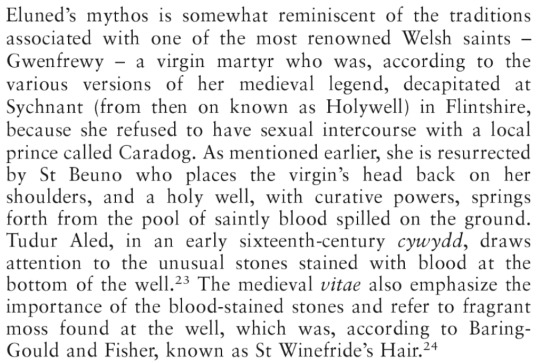
Jane Cartwright, Feminine Sanctity and Spirituality in Medieval Wales
6 notes
·
View notes
Note
For the Witcher asks, 1, 7, 14, 21, 25, 29.

Oh jeez, that’s a lot of questions
1. What’s your favourite monster?
That’s tricky because I would have to say higher vampires, but I don’t really see them as monsters? I see them more on the nonhuman side of the scale. So yeah, if I had to choose another I’d say Leshens. They’re ancient and mysterious and their designs are super cool.
7. What did you do “in the Heart of Woods” and “the Nithing”?
I sided with Sven, had the woman exiled instead of killed, and killed the leshen. And i turned the Nithing curse back on Jonna because fuck her jfc
14. Do you regret any of your choices?
Yes. Okay next question.... just kidding, i regret romancing Yen and having messed up the spotted wight quest, where i missed that you could break the curse
21. Which hair cut is Geralt wearing right now?
Shaved sides and ponytail
25. Do you dye your armor?
Not usually, I’ve only done it once and that was the grandmaster ursine armor, which i dyed dark blue.
29. Do you read the books and notes? Do you have any favourites?
Yes, i read them all! I have so many favourites, like My Evening With a Vampire, which I read before I knew who Regis was so i didn’t remember that it was him in the book until i reread it recently. Another fave is a note i found at a noticeboard in Skellige (I think) where a guy was so overjoyed he had a daughter that he had to tell everyone. And then there’s this note at the notice board in Velen’s Nilfgaarian war camp, titled “Looking for Gingermuffin”
By mistake a letter was delivered to me that was meant for someone else. I have lost the envelope. The missive starts with the words, "My Sweetest Tender Gingermuffin" and is signed by "Your Ever Loving Little Goosey." Gingermuffin, please report to Sergeant Gwenfrewi.
31. What happened to Olgierd?
He’s alive and well. Or as well as can be.
34. How do you feel about Avallac’h?
I liked him better in the books, but I like his design in the games (except for those excessive cheekbones), especially his eyes.
37. Do you play Gwent? Do you have a favourite faction?
No.
40. Where would you want Geralt to live (other than Corvo Bianco)?
No where. Only Corvo Bianco. With Regis and NOT Yennefer.
0 notes
Text
2005: Quenton Pramick is Not My Boyfriend
Gwenfrewi, a weird high school student, has her world turned upside down when her bff, ultra geek Quenton, announces he is switching schools. Maybe she is in love with him after all? Or maybe it’s just that he’s literally her only friend. What even happened with all of her former friends? Whatever, they suck.
1 note
·
View note
Text
Mystic Wells - British Goblins CT030
Mystic Wells
British Goblins: Welsh Folk Lore, Fairy Mythology, Legends and Traditions (1881)
Book 4 Chapter 2
by
Wirt Sikes
All about the beheading of St. Winnifred and the mystic well that sprang up where her head fell. How the waters of mystic wells can be either beneficent or malicious - they can cure diseases, mental or physical, as well as curing love-sickness. Sikes also tells us sooe of the stories associated with Barry Island.
Running Order:
Their Good and Bad Dispositions 1:46
St. Winifred's Well 4:48
The Legend of St. Winnifred 6:35
Miracles 9:28
St. Tecla's Well 11:50
St. Dwynwen's 12:44
Curing Love Sickness 13:00
St. Cynfran's 14:30
St. Cynhafal's 15:23
Throwing Pins in Wells 15:32
Warts 15:36
Barry Island and its Legends 17:08
Ffynon Gwynwy 20:22
Propitiary Gifts to Wells 21:02
The Dreadful Cursing Well of St. Elian's 23:09
Wells Flowing with Milk 25:34
St. Illtyd's 25:50
Tafi's Well 28:40
Sanford's Well 29:31
Origins of Superstitions of this Class 30:48
Names Used in this Section
All proper names, and words in Welsh or other languages, are recorded here in the show-notes and we've done our best to get the pronounciations right for you.
St. Winifred
St. Tecla
St. Cynfran
St. Cynhafal
Barry Island
Ffynon Gwynwy
St. Elian's
St. Illtyd's
Tafi
Sanford
Lourdes, France
Cambria
Ffynon Mair (Well of Mary)
Holywell
Duke of Westminster
Drayton
St. Winifred, or Gwenfrewi
Elerius
Robert of Salop
Cotton MSS.
Caradoc
St. Beino
Lethean
Denbighshire
Gwern Degla
Llandegla
Llandwyn, Anglesea
Dan Cupid
Ffynon Dwynwen (Fountain of Venus)
Iolo MSS.
Seithenhin the Drunkard
Aphrodite
'Rhad Duw a Chynfran lwydd ar y da!'
(the grace of God and blessed Cynfran on the cattle)
Brychan
Abergeleu
St. George's Well
Pennant
Mars
Llangynhafal parish, Denbighshire
Gloucestershire
Barry Island, near Cardiff
St. Barruc, or Barri
Lord Windsor
St. Cadoc
Gwalches
Merlin
Camarthen
Etna
Stromboli
Typhonn
Vulcan
Camden
Malkin
Ffynon Gwynwy, near Llangelyniin church, Carnarvonshire
Archaeologia Cambrensis
Pliny
Clitumnus
Cyff-elian
Llanelian, Denbighshire
Penrhos
Gower, near Swansea
John the Baptist
Canute
River Taff
Newton Nottage, Glamorganshire
British Goblins can be found on Archive.org
You can find out more about Wirt Sikes on Wikipedia.
Try the Celtic Myth Podshow for the Tales and Stories of the Ancient Celts at http://celticmythpodshow.com or on Apple Podcasts.
Our theme music is "Gander at the Pratie Hole" by Sláinte. You can find their music on the Free Music Archive.
Check out this episode!
0 notes
